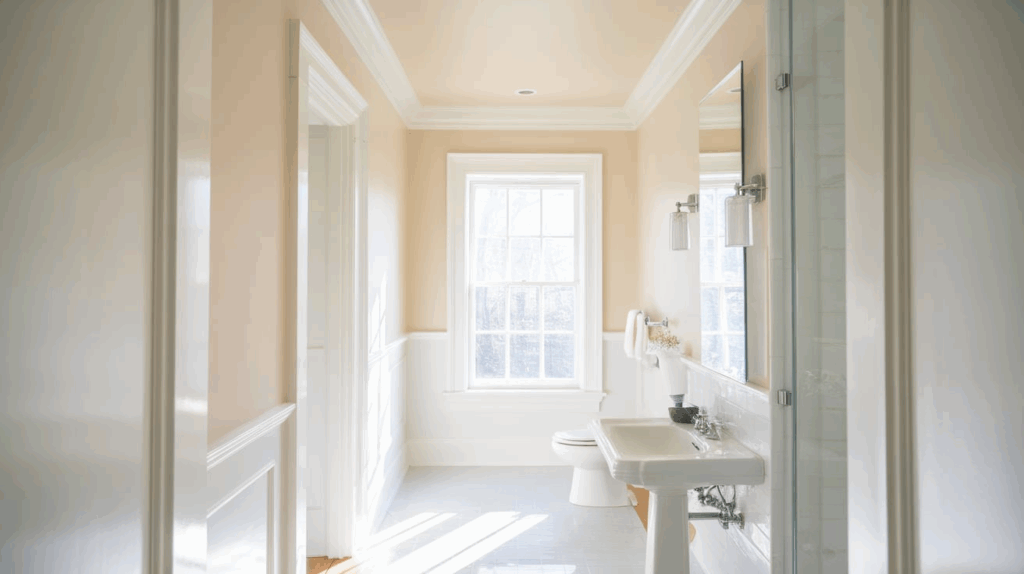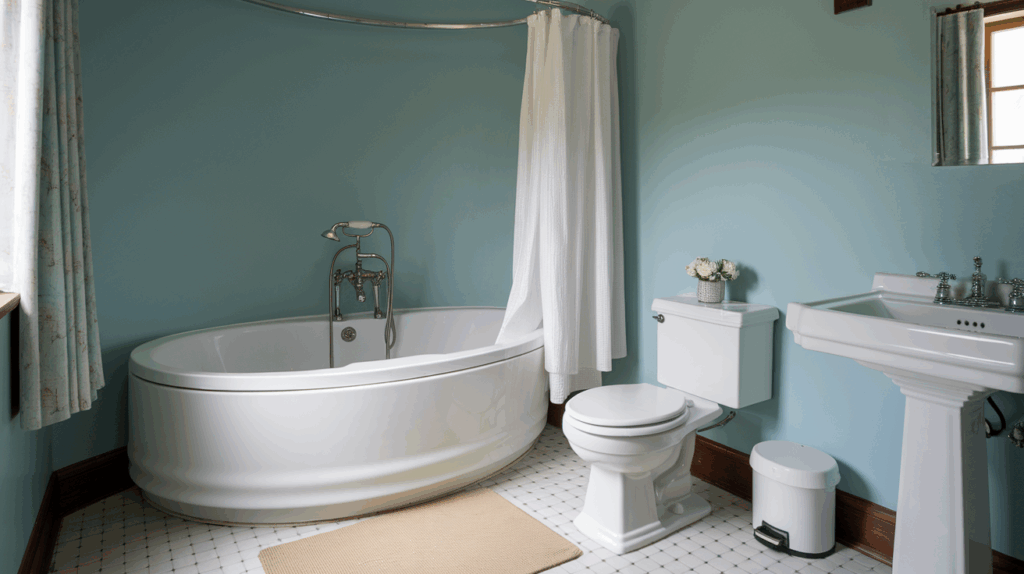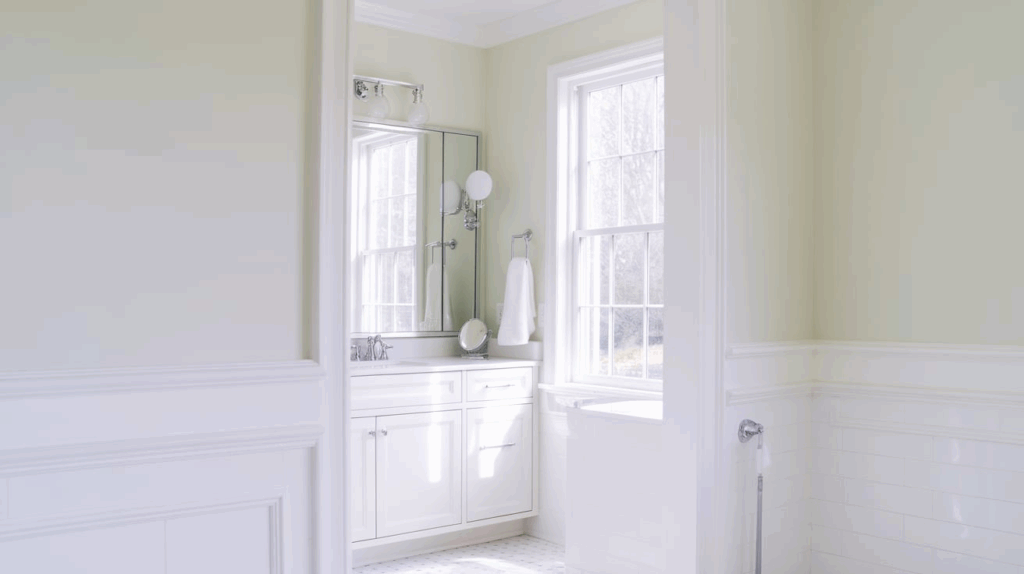When I decided to paint my bathroom, I quickly realized that many factors influence the overall cost, and it’s not just about buying paint.
The size of your bathroom, the type of paint you choose, and the amount of prep work involved all play a significant role. If you’re like me, setting a clear budget before starting is essential to avoid surprises.
In this guide, I’ll break down the average costs, explain what affects pricing, and share tips to help you save money without compromising on quality.
Whether you choose to hire a professional or paint yourself, knowing what to expect will help you plan more effectively and achieve the best results.
Ready to refresh your bathroom without breaking the bank? Let’s get in and find out how much it actually costs!
Average Cost to Paint a Bathroom

When it comes to painting a bathroom, costs can vary quite a bit depending on the size and condition of the space. On average, painting a bathroom can cost anywhere from $300 to $1,200 or more, depending on various factors.
- DIY Painting: If you paint the bathroom yourself, you can expect to spend roughly $300 to $800. This includes purchasing paint, brushes, rollers, tape, and other supplies. Smaller bathrooms tend to cost less because they require less paint and labor.
- Professional Painting: Hiring a professional painter typically costs between $500 and $1,200, depending on the bathroom’s size and complexity. Professionals charge for labor, which can significantly increase the total cost, especially if prep work is needed.
Bathrooms with complex layouts, damaged walls, or high ceilings will increase the price. Knowing these ranges helps you set realistic expectations before starting.
Factors that Affect Bathroom Painting Costs
Understanding these factors helps you plan better, make informed choices, and avoid unexpected expenses during your painting project.
- Bathroom Size: The larger the bathroom, the more paint and labor are required. Small bathrooms around 40–50 square feet are less expensive to paint than master bathrooms or those with complex layouts.
- Paint Quality and Type: Higher-quality paints cost more upfront but provide better coverage and durability, especially in humid spaces like bathrooms. Specialty paints like mildew-resistant or semi-gloss finishes are typically pricier.
- Surface Condition and Prep Work: If your walls need extensive prep, such as patching holes, sanding, cleaning mold, or priming, that adds to the time and materials needed, increasing costs. Pristine walls require less prep and cost less overall.
- Number of Coats: More coats of paint mean more paint and labor time, both of which raise the price. Dark colors or drastic color changes often require additional coats to achieve good coverage.
- Complexity of the Job: Bathrooms with lots of trim, molding, cabinetry, or unusual angles require more detailed work and time, which can increase labor costs.
- Labor Costs: Hiring a professional varies by location, experience, and demand. Urban areas tend to have higher labor rates compared to rural regions.
Labor Costs: DIY vs. Hiring a Professional
Let me walk you through your options for countertop installation. Understanding the differences can save you time and money.
| Aspect | DIY Painting | Hiring a Professional |
|---|---|---|
| Cost | Saves money on labor; only pays for supplies | Labor costs range from $30 to $60+ per hour, increasing the total price |
| Time & Effort | Requires significant time and physical effort | Faster completion with skilled efficiency |
| Skill Level | Needs some painting skills and patience | Experienced painters deliver high-quality results |
| Supplies | You must buy all materials and tools | Pros often provide their own supplies |
| Risk of Mistakes | Higher risk of uneven finishes or errors | Lower risk due to professional expertise |
| Stress | It can be stressful managing the whole project | Less stress; pros handle prep and cleanup |
Paint Types and Their Price Differences
Not all paints are created equal, and the type of paint you choose makes a difference in cost and performance.
| Paint Type | Description | Typical Cost per Gallon | Key Features |
|---|---|---|---|
| Latex Paint | Water-based, quick drying, easy cleanup | $20 – $60 | Popular for bathrooms; affordable and versatile |
| Oil-Based Paint | Durable, smooth finish, longer drying time | Higher than latex | Less common in bathrooms; requires special cleanup |
| Mildew-Resistant Paint | Special formula to prevent mold growth | Higher than standard latex | Ideal for humid bathrooms; prevents mildew |
| Semi-Gloss/Glossy Finishes | Moisture-resistant, easy to clean | More expensive | Durable finish; good for high-moisture areas |
Cost Breakdown for Walls, Ceilings, and Trim
Painting walls, ceilings, and trim varies in cost due to differing labor and materials, helping you budget effectively.
- Walls: Walls typically cover the largest surface area in a bathroom, so they require the most paint and labor. On average, painting bathroom walls costs between $200 and $500, depending on size and condition.
- Ceilings: Painting the ceiling is often optional but recommended for a finished look. Adding ceiling painting can increase your total cost by about $50 to $150, depending on height and area.
- Trim and Moldings: Painting trim, baseboards, and door frames requires precision and more detailed work, often costing between $100 and $300. This part involves taping, cutting in, and sometimes multiple coats.
| Area | Average Cost Range | Notes |
|---|---|---|
| Walls | $200 – $500 | Largest area, multiple coats and prep needed |
| Ceilings | $50 – $150 | Optional: flat paint; extra labor for height |
| Trim and Moldings | $100 – $300 | Precision work, multiple coats, labor-intensive |
Prep Work Costs for Cleaning, Repairs, and Priming
Prep work like cleaning, repairs, and priming adds to costs but is essential for a smooth, durable bathroom paint job.
- Cleaning: Proper cleaning removes soap scum, mildew, and grease that prevent paint from sticking. Professional cleaning costs between $20 and $100, depending on bathroom size and condition.
- Repairs: Repairing holes, cracks, or damaged drywall ensures a smooth surface for painting. Minor repairs usually cost $50 to $200, while extensive damage or drywall replacement can increase expenses.
- Priming: Priming seals surfaces and promotes paint adhesion, especially over stains or dark colors. Primer costs $15 to $40 per gallon, with professional application adding $50 to $150 in labor.
How to Save Money on Bathroom Painting?

Painting your bathroom doesn’t have to break the bank. With a few smart strategies, you can achieve a beautiful result while keeping costs down.
- Do It Yourself: Taking on the painting project yourself is one of the biggest ways to save money. Labor often accounts for a significant portion of the cost, so if you have the time and confidence, DIY painting can dramatically cut expenses.
- Choose Mid-Range Paint: You don’t always need premium paint to get great results. Mid-range paints offer good durability and coverage at a more affordable price. Look for quality brands on sale or at discount retailers to get the best value.
- Limit Prep Work: Prep work like cleaning, patching, and priming adds time and cost. Doing minor repairs yourself before hiring a painter can reduce labor charges. Even simple cleaning and sanding can make a big difference in paint adhesion.
- Paint Only Walls: If your budget is tight, focus on painting the walls first. Skipping ceilings, trim, or cabinetry saves materials and labor. You can always add these later when your budget allows.
- Shop Sales: Keep an eye out for paint and supplies on sale or clearance at home improvement stores. Buying during seasonal sales or using coupons can save you significant money.
When to Choose High-End Paint?
Sometimes investing in high-end paint is worth the extra cost, especially in bathrooms.
If your bathroom has high humidity or poor ventilation, mildew-resistant paint can prevent mold growth and keep walls looking fresh longer.
Bathrooms that get heavy use also benefit from durable, washable finishes that stand up to frequent cleaning without wearing down.
For textured or metallic finishes, premium paints give better coverage and depth.
While these paints cost more upfront, they often save you money in the long run by reducing the need for frequent maintenance and repainting.
Choosing the right paint for your bathroom’s specific needs helps ensure a beautiful, lasting result.
Getting Accurate Quotes from Painters
If you decide to hire a professional, obtaining detailed and accurate quotes is key.
- Ask for written estimates including paint, prep, labor, and cleanup.
- Confirm whether paint quality and brands are included.
- Check references and reviews to ensure quality.
- Don’t automatically pick the lowest bid; consider experience and reputation.
Tip: Clear communication helps avoid hidden fees or surprises.
Conclusion
Painting your bathroom doesn’t have to break the bank. I’ve walked you through every cost detail – from materials to labor, helping you budget smartly.
If you’re a DIY enthusiast or prefer hiring professionals, you now have the knowledge to make an informed decision.
Key takeaways:
- Average painting costs range from $300 to $1,200
- DIY can save you significant money
- Professional painters offer quality guarantees
I’ve broken down costs, shared money-saving tips, and given you realistic expectations. Your bathroom makeover is closer than you think.
Ready to refresh your bathroom? Your perfect paint project starts here.
Let’s make your vision a reality – one brushstroke at a time. Check your budget, grab those paint swatches, and turn your space without breaking the bank.
Questions? Drop a comment below!

